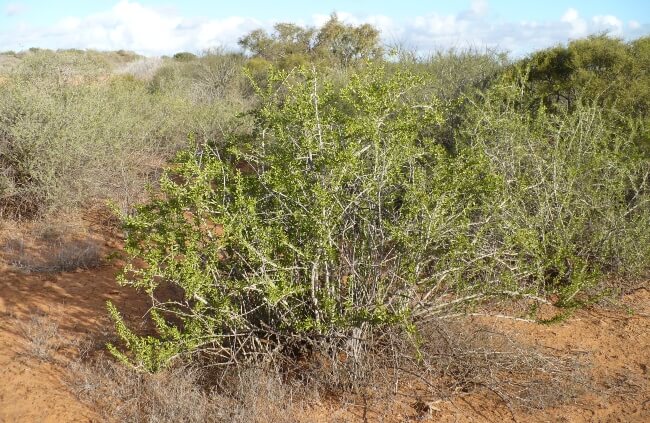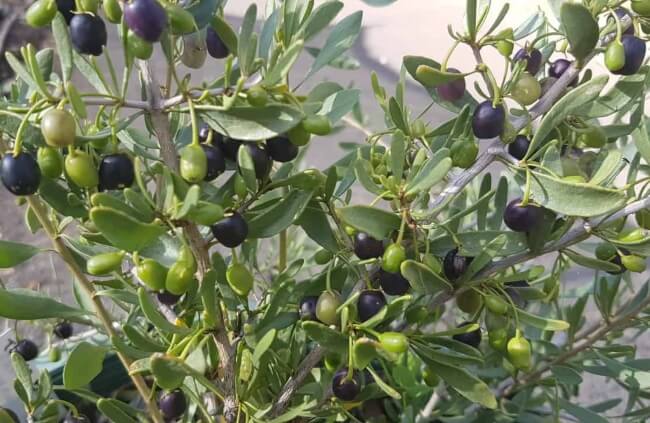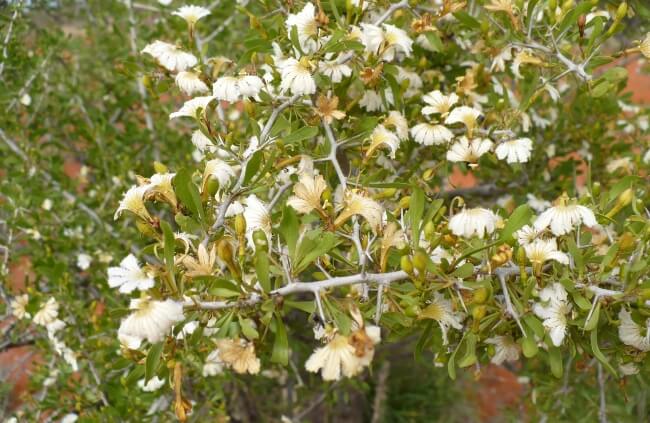Maroon Bush, or the Prickly Fan Flower, is an entirely edible shrub, used for traditional treatments of stomach upsets and certain types of cancer. While it is not recommended for medical use today, the berries and leaves make a wonderful tea.
More...
Family: | Goodeniaceae |
|---|---|
Genus: | Scaevola |
Species: | S. spinescens |
Common names: | Currant Bush, Maroon Bush, Prickly Fan Flower, Murin Murin |
Origin: | Australia |
Location: | Outdoor |
Type: | Edible, bush tucker, shrub |
Growth: | 1-2 m tall, 1.5 m wide |
Sun requirements: | Full sun or light shade |
Foliage colour: | Green |
Flower colour: | White with yellow centre |
Flowering: | Year-round flowering |
Edible parts: | Leaves, berries and roots |
Maintenance level: | Low |
Poisonous for pets: | No |
What is Maroon Bush?
Maroon bush is one of several common names for Scaevola spinescens, a native Australian shrub with several traditional medicinal applications, and a beautiful structure for ornamental gardens.
Native to Australia, and spread widely across every state other than the extreme North and far South, it is a very resilient plant, well suited to most soil types and a range of growing conditions.
Identifying Maroon Bush
Maroon bush is fairly easy to identify, generally found growing in open space without any competing flora. Its mature leaves are ovate with rounded tips, and a slightly fleshy appearance. Young foliage is much larger with a shiny, waxy finish.
Flowers of maroon bush are white, fan-shaped flowers with bright yellow centres and frilled borders to each petal. As the fruit develops it ripens unevenly, and flowers continue throughout the year, attracting pollinators and birds in all seasons.
Fruit starts out like hard green olives, and ripens to a rich, purple, almost black plum.
Common Uses of Maroon Bush
Maroon bush tea, made from the leaves, roots, or stems of the plant, is commonly used for treating stomach complaints, particularly stomach, intestinal, or liver discomfort
There are many reports of Maroon bush’s ability to support cancer treatments, with the most commonly cited being the 1935 case of Albert Nebrong, an Aboriginal man who supposedly cured his tongue cancer with Bush Tea from this plant.
The berries can be used in the same tea preparation, by boiling, and then steeping overnight at room temperature. Strain the tea in the morning, and store it in sterilised bottles for up to six weeks.
The fruit itself, when ripe, is absolutely delicious, with a rich flavour, like redcurrants and custard. If picked before it is fully ripe (deep purple skins) it has an intensely bitter flavour and an overwhelming citric earthiness.
Safety Notes and Medical Restrictions in WA
Maroon bush preparations for medicinal use are specifically banned in Western Australia, and it is classified as an S4 poison to avoid misuse in partnership with modern cancer treatment.
There is limited evidence that Maroon bush is toxic, and the WA authorities accept it is useful in reversing the negative side effects of chemotherapy. However, users can become more reliant on Maroon bush tea than evidenced medicines, and reduce the overall quality of their treatment.
Today, Maroon bush is only prescribed as a mood-boosting drug for general well-being, and is otherwise protected, meaning it cannot be harvested from the wild in WA.


Get Your Free Guide:
Master Growing Australian Natives eBook
A Must Have Complete Guide for Every Australian Garden
Get Your Free Guide:
Master Growing Australian Natives eBook
A Must Have Complete Guide for Every Australian Garden
Read more about the medicinal potential applications of Scaevola spinescens.
How to Grow Maroon Bush

Source: Department of Agriculture and Food
Growing your own maroon bush is incredibly simple if you can find a plant to start from. They are a protected species, following interventions from the medical community, to limit home remedies for serious illnesses, so harvesting from the wild and taking cuttings is not permitted in some states.
However, once you get started, they take very little looking after and respond well, and noticeably to any feed you give them.
Ideal Growing Conditions
Soil conditions are not particularly important if you are growing maroon bush as an ornament, but if you plan on harvesting any part of the plant, add plenty of moisture-retentive organic matter (leaf compost or well-rotted manure).
Maroon bush grown in sandy, arid conditions develops a bitter flavour. It has the same medicinal properties when harvested but without the sweetness of plants grown in richer soils.
Basically, they like Mediterranean conditions, but with a bit of help. Think lavender rather than rosemary. You can grow maroon bush with free drainage and poor soil, but like lavender, richer soils and well-fed plants tend to produce more flavourful, fragrant produce.
As for sun, aim for 8 hours of full sun per day. They can cope with dappled shade, and a little less light, but grow best through hot summers.
Scaevola Spinescens Propagation
Cutting from cultivated plants is the easiest way to reproduce these medicinal edibles, but take a few to increase your chances of success.
- Fill a deep 15-20 cm plastic pot with free-draining compost or pure perlite.
- Cut several 15-20 cm lengths of 1-year-old growth.
- Trim any flowers or buds.
- Dip the cut ends into the rooting hormone (powder of gel).
- Gently insert it into your potting medium.
- Water thoroughly, and cover with a clear plastic bag to preserve moisture.
- They take about two months to root in summer, so leave them out of direct sunlight, but in a warm, reasonably bright place.
- Water once every couple of weeks if the compost or perlite dries out completely.
Maroon bush is not a threatened species, but it is protected. Please be responsible and check local regulations before taking cuttings from wild plants.
How to Care for Maroon Bush
Once planted, there’s really very little you need to do to maintain a healthy maroon bush, they are reasonably long-lived shrubs, and completely frost-hardy after their first year in the ground (protect young plants from winter frost in their first year).
The only common advice for everybody is to remember that they have a sweeter flavour when grown in good loamy soil. For sandy gardens, that might mean growing them in pots or simply mulching once every 2-3 years to maintain soil health and help manage moisture.
For plants in pots, feed with liquid seaweed once a month in summer to help retain soil structure, similar to caring for rosemary, lavender or potted citrus plants.
Common Problems When Growing Maroon Bush
Root rot caused by poor drainage is about the only thing that can kill a maroon bush. They can suffer from some pest damage when grown in arid conditions – red spider mites in particular, which can spread fungal leaf infections, but they are rare, and generally self-resolving.
Maroon Bush Frequently Asked Questions

Source: Tucker Bush
What is maroon bush good for?
Maroon bush is good for colds and stomach upsets, and many trials have evidenced its antibacterial and antiviral properties. It is often cited as a possible cancer treatment, but there is limited evidence and medical professionals generally advise against its use for that.
How do you prepare maroon bush?
Maroon bush berries, leaves, flowers, stems, and even roots, can all be used to make tea. Bush tea is the most common way it is consumed. Simmer the plant parts for 30-45 minutes until the water is flavoured. Then steep overnight before straining.
Where can I find a maroon bush?
Maroon bush grows commonly all over Australia apart from the far Northern parts of the Northern Territory, Victoria and Tasmania. Cultivated plants can be responsibly sourced from specialist native nurseries.
What are the common names for Scaevola spinescens?
Scaevola spinescens has many common names: maroon bush, currant bush, prickly fan flower and Murin Murin. Murin Murin is its original Noongar name.
Is Maroon bush evergreen?
Maroon bush, Scaevola spinescens, is a hardy evergreen plant. It holds its foliage all year round, and in most parts of Australia will not only hold its leaves but continue to flower and fruit through every season.
Wrapping Up Our Maroon Bush Guide
While the medicinal uses of the maroon bush might not be fully researched, there is plenty of evidence and a weighty social history backing up the therapeutic use of Scaevola spinescens.
But even if you’re not 100% certain of its usefulness, you can’t deny how spectacular the plant looks when it is covered in olive-like fruit.
Published on September 6, 2025 by Nathan Schwartz
Last Updated on January 27, 2025





